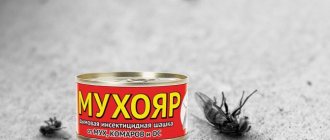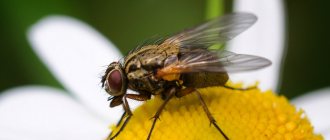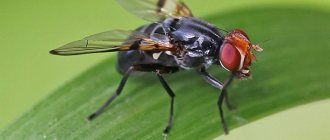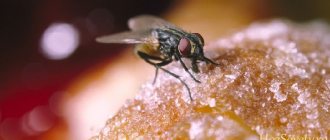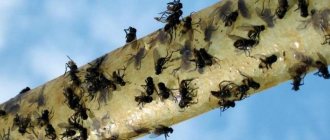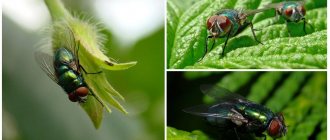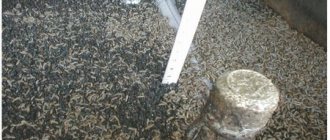flies
Fly breeding cycle
The rate of reproduction of dipteran insects is amazing. The flies that emerge from pupae in April become ubiquitous by autumn. But the rate of reproduction is much higher than one might imagine. If one pair is allowed to mate unhindered, by autumn there will be 5,598,720 million flies on the globe. If it were not for insectivorous birds and mammals, there would be nothing on Earth except these insects. Of no less interest is the fact of how long flies live. This indicator depends on a number of factors.
Lifespan
There are 5 thousand species of true flies from the Muscidae family on the planet. The lifespan of flies of different species differs in duration. You also need to take into account how the life expectancy of a fly was calculated: from an egg or only for an adult insect. But in all cases, the duration of the fly’s life cycle depends on external conditions: the higher the temperature and the more food, the more actively the maggots develop and the shorter the adult lives.
On a note!
The shortening of the life of an individual adult does not affect its fertility.
When a fly's life speeds up, the eggs in its abdomen mature faster. And due to the rapid change of generations, the overall increase in the number of individuals in the population is accelerating. Some species are viviparous and lay larvae instead of eggs. It is not at all clear from what moment to start counting life expectancy: from the moment the egg is born in the abdomen, from the time the egg is laid, or from the beginning of the last phase of life.
Chemical substances
Insecticides are most often used when you need to get rid of a large number of insects. Despite this, they can also be used to kill several individuals. The best means include:
If desired, you can purchase other professional products. The choice of drug depends only on the person and his preferences.
Important: in winter, it is better to purchase odorless chemicals so as not to “drive” family members and animals outside.
Fumigators can also be considered effective means. These devices kill flies and prevent their appearance. Fumigators work on plates or bottles of liquid.
Physical means
Small numbers of insects can be controlled using traps. They are:
The first type of trap includes sticky tapes. They are sold at any household chemical store. The trap is attached to the ceiling or any other vertical surface. After this, insects flock to it.
The second type of traps is made independently. Take a plastic bottle and cut off the neck. After this, a sweet bait is placed inside:
When the filling is placed, all that remains is to turn the neck over and then insert it into the cut bottle. The fly, attracted by the smell, will enter the trap, but cannot get out.
Poisonous baits are purchased in the store. They are available in the form of a suspension. It is enough to drop a little substance onto the lid or other surface. After that all you have to do is wait.
Important: poisonous baits are not dangerous for people and animals.
Traditional methods
If you don’t want to run anywhere, it is recommended to use folk methods that have proven themselves over centuries:
- Milk solution. This product is used to treat walls, jambs and window sills. To prepare the solution you will need 0.5 liters of sweet water (sugar is added to taste), 100 ml of formaldehyde and 300 ml of milk. Everything is thoroughly mixed. After this you can hunt flies.
- Black pepper. The spice is mixed with granulated sugar. After this, the mixture is ready for use.
- Saccharin solution. For 200 ml of warm water, take 20 grams of honey and 2 grams of saccharin. Newspaper or thick toilet paper is soaked in the finished mixture. The trap is placed on the windowsill.
Important: all solutions and baits must be kept away from children and animals.
Reproduction of sprout fly
The pest reproduces in different sexes; the difference between the structure of males and females is not noticeable at first glance. Distinctive features are hidden on the legs; long bristles grow on the hind legs and thighs. The body size of flies is 3-6 mm. In warm regions they fly out of the ground in mid-April, in temperate zones - in the second or third ten days of May. After mating, the female lays eggs in the soil. She prefers moist soil fertilized with manure. The eggs are white, oblong, with a relief pattern. Their length is about 1 mm, the number is 50-60 pieces. Embryo development takes from 3 to 10 days.
Information. In dry soil, the eggs die quickly.
The sprout fly prefers to breed on cucumbers. The larvae climb into the stem of the plant, weakening it. At birth, their length is 1-2 mm, the color is transparent. After a few days the larvae turn white. Depending on conditions and nutrition, their development takes 10-30 days. Before pupation, it becomes thick and fleshy, growing up to 7 mm. The head is practically absent; two dark mouth hooks are visible in the narrow anterior part of the body.
Attention. The most harmful are the offspring of the first generation, which damage the sprouts. The impact of the larvae on a mature plant is less destructive.
Next, the larva turns into a pupa, while it remains in a hard larval skin called the puparium. This is a brown-yellow oval cocoon 5 mm long. In summer, the adult appears after 2 weeks. If the clutch is made in the fall, it remains in the cocoon until spring. The insect burrows 10 cm into the soil and experiences a cold period there. When the air warms up to +100, the imago will tear the puparium along the front seam and escape into the wild. The second generation flies in June, and the third in July.
Information. The main life stage of the germ fly is the larval stage. At this stage, she actively feeds and spends most of her life cycle. The function of the imago is dispersal and reproduction.
Where does the fly hibernate? Whychek Club
Family of real flies
(lat.
Muscidae
) refers to
short-winged dipterous insects
, it includes about 5 thousand species, divided into more than a hundred genera.
But most often the flies that we meet in our apartments belong to the housefly species.
In addition to them, we also encounter
blowflies, flies,
and fruit flies
- fruit flies.
From left to right: housefly, green blowfly, gray blowfly, fruit fly, autumn fly
Even the smallest children can guess the riddle: “Who is above us upside down?”, because everyone knows the ability of flies to walk on any surface - the ceiling, window glass, mirrors. In this they are helped by claws and hairs on the tips of their paws (with which flies cling to the smallest uneven surfaces) and tiny pads located there that secrete a sticky liquid. With the help of the pads, when walking, flies stick even to smooth glass and are not afraid of falling. By the way, this is why the fly has to rub its legs all the time - it cleans them from dirt stuck to the pad. The funny children's rhyme “A fly sat on the jam, that's all the poem” reflects another fact from the life of flies - that they love sweets very much. In general, houseflies feed on the same things as humans. But they feel the taste of food not with their tongue, like we do, but with their tongue. feet. On the front legs of flies there are tiny hairs - taste organs. Therefore, we often observe how flies rush around, run around the table, sit on all objects - they choose food to their taste.
But catching flies running on the table is not an easy task. The person just swings, and the fly immediately takes off and flies away. It is not difficult for a fly to notice our movements. Her large bulging eyes see around 360 degrees - both in front and behind. And they themselves consist of almost four thousand small elements - facets. Each of them sees only a part of the image, so the flies see a mosaic picture assembled from four thousand pieces! Invite your child to assemble a puzzle of hexagons, just as a fly assembles an image of the surrounding world.
Although this way the image is not very clear, it is colored - flies even see ultraviolet waves that humans cannot see. In addition, a fly perceives an image much faster than a human. For us, the change of frames in cinema merges into continuous movement already at a speed of 24 frames per second. But such a film is not suitable for a fly - it will seem too “twitchy”. To make a movie for a fly, you would have to change frames 300 times per second! That is why our fastest movements for her are no faster than the speed of a turtle - flies always manage to dodge a hand swinging at them.
There is also a wonderful fairy tale by D.N. Mamin-Sibiryak, “The Tale of How the Last Fly Lived.” Despite its general naturalism, unfortunately, it contains several erroneous facts about the life of a fly, which I will discuss separately. That's probably all. But our flatmates deserve more attention from us. Imagine, even about the number of legs a fly has for almost two thousand years there was no true information! Until the 18th century, theoretical considerations and the authority of ancient scientists were considered a priority in science, and experiments were practically not carried out. Therefore, the false statement made by Aristotle (according to some sources, this is a mistake not of Aristotle himself, but of his copyists), that a fly has 8 legs was taken for granted by scientists all this time, until Carl Linnaeus thought of counting the legs of a real fly and I found out that there are only 6 of them, like all other insects.
Life cycle and features
Flies are insects with complete metamorphosis. This means that the reproduction and development of a fly goes through several stages, namely egg, larva, pupa, and adult. All stages of the life cycle differ in habitat, feeding method and morphology.
Reproduction of flies (meat flies, house flies and others) begins from the moment of mating of individuals at the adult stage. Males attract females using sound signals they make with their halteres. Fertilization occurs inside the female's body.
On average, after 2 days the female lays up to 200 eggs and is again ready to mate. If all the eggs of one fly survived, then during her entire life, which lasts up to 2 months, the female would give birth to 3 thousand offspring. This is 8-9 generations, which would increase the number of descendants of the first fly to 5 trillion individuals. This is the amazing rate of reproduction of flies.
The full cycle of transformations from egg to adult in flies takes 10-20 days and depends on temperature.
Where do mosquitoes come from in the house?
It will not be a discovery for modern man that not picky insects can settle near a person. Various means of fighting mosquitoes, such as repellents, inspirators, folk methods, represented by strong odors of spices or citruses, will help to briefly protect the body from bites. What body of water is necessary for the reproduction and residence of bloodsuckers?
In summer there are most mosquitoes near the pond
The squeaking mosquito, which is widespread in our latitudes, does not necessarily need a pond, swampy area or wet forest; they quietly coexist in the shade of garden trees, a small puddle from a leaking tap.
Can insects live in an apartment?
The answer to the question whether mosquitoes can live in an apartment will puzzle many. Malicious bloodsuckers calmly settle down next to a person, preventing them from sleeping peacefully at night or resting during the day. How do they get into the home?
- A characteristic feature of old apartment buildings is a flooded basement or leaking roof. Insects will like such a “cozy” place.
- A bloodsucker flying around a living space often flies through a window without a mosquito net. This problem will be solved by using a fumigator or spiral.
- The situation is worse if female mosquitoes get home through the entrance door or ventilation shaft. You can get rid of persistent insects by treating the basement with chemicals.
In what month will the annoying buzzing stop? If the conditions are comfortable for reproduction, there is constant humidity and a stable above-zero temperature, then mosquitoes will bite all year round.
Where do mosquitoes go during the cold season?
Mosquitoes overwinter in tree bark
Where do mosquitoes spend the winter?
- At home, the insidious insect will easily hide in the gap between the walls, wooden openings, darkened and hard-to-reach corners.
- In nature, mosquitoes crawl under the bark of trees and leaves in winter.
- Eggs can remain frozen near ponds, streams, and even near a puddle.
Any place with a positive temperature, be it a barn, basement, cellar, is suitable for mosquito wintering.
If the bloodsuckers haven't disappeared
What to do if bloodsuckers do not disappear after the onset of frost? There is a list of necessary measures that should be taken if mosquitoes bother you all year round.
- Check the sewer system and associated plumbing fixtures for leaks.
- General cleaning of the premises sometimes helps to detect the mosquito's wintering place.
- Excessive humidity at home will also be a good opportunity for harmful insects to overwinter.
- Treating cracks with insect repellent sprays will increase your chances of eradicating your mosquito problem.
According to archaeologists, today's mosquitoes, which constantly attack us, have remained virtually unchanged over the 46 million years of their existence. This means that they survived the Ice Age 2.5 million years ago and remained completely unscathed.
But a mosquito is a cold-blooded insect. So how does it survive the cold weather? How do mosquitoes winter? And in today’s article we will talk about this in detail.
The lifespan of a male mosquito is only 10 days and then it dies. This happens immediately after mating.
Therefore, men never face frost problems. Female mosquitoes, on the other hand, spend the colder months inactive, hidden in protected areas such as empty logs, etc.
Mosquitoes enter a period of rest, which is very similar to the sleep of a bear or squirrel, during the winter season. Mosquitoes can remain in this state for up to six months.
Survival in the cold
Insects are creatures that depend on the sun's heat. When cold weather sets in, they try to hide in cracks where they can spend the winter. The colder the winter, the fewer individuals will survive. Usually either larvae or pupae overwinter in the ground. For most flies the situation is similar. An adult insect rarely survives winter. The crude expression “they die like autumn flies” has a basis: dipterans die during cold weather. And not only from frost, but also from infection with mold.
The insect cannot sleep for the winter. It falls into a torpor, from which it can emerge even in the middle of winter. The sun's rays only need to heat it up. This explains the appearance of single individuals in apartments even in the middle of winter. But such a “winter” fly is doomed to die.
On a note!
In winter, large flies that are less sensitive to cold usually wake up.
Most species live in natural conditions and the main problem for people in apartments is caused by ordinary flies. They are either house or indoor. When considering the development cycles of flies, it is better to focus on this type of insect, since it is unlikely that anyone is interested in the distant and infertile tsetse or the hunchback bee living in the apiary.
Flies in winter
The wintering process for insects occurs in different ways. How flies overwinter depends primarily on what species a particular individual belongs to, as well as on its habitat and climatic conditions. It’s worth starting with the fact that the lifespan of a fly is not long and averages only 3 to 5 weeks. Therefore, the question of wintering concerns only young flies that were born in the fall, as well as larvae that hatched from eggs laid in the fall.
A state of diapause helps flies survive the cold season. All life processes, including metabolism, slow down, and the body’s resistance to negative external conditions increases. This manifests itself in the fact that with the onset of cold weather, insects become lethargic, slow, and their activity noticeably decreases. Flies fly less and less, preferring to crawl and then hibernate.
By the way, thanks to suspended animation, the lifespan of a fly increases significantly. After all, it includes all the autumn and winter months that the insect spent in hibernation. The flies that bother people in early spring are those flies that were born in the fall and overwintered. You can recognize an autumn fly by its uncertain, seemingly slow-motion flight. After all, insects need some time for all vital processes to return to normal.
According to research, only fertilized females survive the winter, and males die in most cases.
Where do flies go in winter?
Scientists' observations confirm the fact that most often, with the onset of the first autumn cold weather, flies gather in large groups and together look for the most suitable place where they will spend the winter in the future. But some individuals do not participate in collective searches and prefer to find a warm place for an individual comfortable wintering.
The conditions under which flies will sleep in winter should not only ensure the survival of insects at low temperatures. It is equally important that with the onset of spring and increasing daylight hours, insects can feel the warmth and wake up.
Most often, flies get into the cracks and crevices of buildings, hide in the gaps of window frames or between window panes, in basements, on glazed balconies and loggias. Many find shelter in houses, barns, livestock or poultry buildings.
The barn or chicken coop is warm enough, and there is always plenty of fresh manure there, which will serve as both food and a suitable substrate for laying eggs. That is why individuals overwintering in such conditions often do not hibernate in winter, but continue their life cycle.
Some species try to hide in the ground. But this way you can only survive a mild winter; if the frosts are severe, the ground will freeze and the flies will die.
How do larvae overwinter?
Not only flies overwinter, but also larvae that were born shortly before the onset of cold weather. They, like adult individuals, stop feeding and growing in winter, and with the onset of warmth, their development resumes. The larvae most often spend the cold season either in deep layers of soil or in manure. They can also remain over the winter in some kind of rotting mass, for example, in a pile of leaves or grass left over from the fall.
Why do flies appear in the house in winter?
A fly flying in an apartment in winter is not such a rare event. In the middle of winter, a familiar buzzing sound is suddenly heard, and then an insect, not quite confidently moving in the air, appears in the field of view. More often than not, everything works out without even a buzz. It’s just that a sleepy fly suddenly appears on a wall or window glass, which even crawls with difficulty. This does not mean at all that the insect has just entered the apartment. Most likely, this happened in the fall, when the insect was looking for a comfortable place to winter and flew into the house, attracted by the warmth, and possibly by the alluring smells of food.
The same applies to larvae. Perhaps they have been in the house for a long time, and favorable conditions were the reason that the insect did not fall into suspended animation, but continued to develop, and over time a young fly appeared.
Where do flies come from in winter?
There are two main ways flies appear in an apartment or house. Insects can fly into the room on their own or they can be brought by someone in the household. In winter, the picture changes a little, since it is clear that an insect cannot fly in from the street. But a fly can make its way from a warm basement or attic through the ventilation system, or can enter from the sewer system.
Stages of Development: A Brief Outline
For a general understanding of the development, reproduction of flies and ways to combat them, it is not a pound of raisins to know the conditions of development of all stages.
The first step in the development of a fly is the egg. This is the shortest period of the life cycle (up to 24 hours), but also the most important. Flies make clutches in our waste, corpses, garbage pits, and rotten food.
A larva emerges from the egg, which looks like a thin white (binding thread). The larva actively feeds for 5-7 days, increasing its specific weight by 800 times. Then it acquires a brown color, and the tolkun moves to the next stage of its development.
The beloved beauty is a passive stage of the life cycle that lasts up to 5 days. At this time, an important metamorphosis (transformation) occurs inside the pupa - the bride of the imago is formed from the shapeless larva.
Reproduction in winter
Due to living next to heat-producing animals, the house fly can afford not to sleep in winter, but to continue its life activities. The life expectancy of adults in winter increases, and the rate of development of larvae slows down.
On a note!
The number of eggs laid by the female in winter and summer is the same.
A house fly produces up to 1000 eggs in its life. But in winter it will take her longer. The female lays about a hundred pieces at a time.
Why do house flies reproduce so quickly?
Of course, this is not due to the fact that they want to cause maximum inconvenience to the person. Firstly, the intensive breeding of flies indoors signals to us that the hygienic situation here leaves much to be desired and immediate measures should be taken to correct this fact.
Secondly, flies allow most types of organic waste to decompose as quickly as possible, so they are a kind of environmental orderlies. From this point of view, the fact of rapid reproduction of house flies is quite logical and justified.
Thus, in this article we looked at the basic principles of breeding house flies. We hope that with the help of this information you will be able to minimize their presence in your apartment. We recommend that you use a professional one if you have to deal with a colony of flies firmly established in your apartment.
How to get into housing
A fly can appear in an apartment in only two ways:
- got pregnant;
- multiplied indoors.
More often than not, the buzzing insect still flies in from the street.
The fly is very agile. It only takes a few seconds for her to “slip” through an open window or door. In addition, the dipteran is distinguished by great flexibility of the body. It will not be difficult for an insect to get inside even through a small damage to the mosquito net.
Wintering of insects.
There are other places where parasites appear - ventilation, cracks and balconies. There is a direct relationship: the more insects there are on the street, the more of them there are in a person’s home. If there is a garbage dump or market near the house, then flies will appear in the apartment often. Moreover, the premises will be attacked en masse.
Also, the general condition of the house plays an important role. When the basement is damp and dirty, insects will actively develop and fly around the apartments. If the garbage chute is faulty, the residents of the house will undoubtedly have a problem with how to get rid of flies, and other parasites as well.
How many days does the Drosophila fly live?
The appearance of fruit flies indicates that fruits or vegetables in the house or apartment have begun to deteriorate. It is interesting that fruit flies do not appear on their own. Their eggs are brought along with food from the store, and when favorable conditions occur (read: when rotting begins), they begin to develop.
An adult fly lays eggs on the fruit while it is still growing. Here is such a “caring” female... The lifespan of Drosophila directly depends on the ambient temperature.
At 25°C the fly lives 10 days, when the temperature drops to 18°C - 20 days. Under ideal conditions (plenty of food and low temperature), a fly can live and actively reproduce for about two and a half months.
How long do flies live without food?
The question itself is meaningless - a fly cannot remain without food unless it is placed in sterile conditions. Insects will always find food for themselves, and flies are able to consume it in liquid and solid form.
Usually the fly lives close to the place where it was born; the radius of its habitat is approximately one hundred meters. The best places for flies to breed are garbage dumps and compost heaps. Rotting waste creates the most favorable environment for the reproduction of insects.
Flies are dangerous to humans because
that they are carriers of dangerous diseases. Crawling over unattended food and eating it, flies leave behind pathogenic bacteria and microorganisms, including worm eggs.
If you conduct an informal survey on the topic “Which insect irritates people the most in the summer,” the fly will deservedly take second place in the ranking after the mosquito. This insect has been annoying all of humanity with its presence since time immemorial. But scientists have been closely monitoring it for a long time and analyzing the data obtained. Of particular interest is information about how long flies live.
At first glance, a harmless creature, but in fact it poses a certain danger in the form of diseases it carries.
How to get rid of insects?
Most often, the problem of how to get rid of flies in an apartment in winter is not particularly difficult. After all, most often we are talking about one, perhaps several accidentally awakened individuals, which, upon awakening, are so lethargic and slow that they can be eliminated without much difficulty.
But sometimes, even in winter, small flies appear in the apartment and begin to actively breed. These could be, for example, fruit flies, which need warmth and food to reproduce, namely rotting fruit, fermented jam, or even the remains of mild alcohol (beer or wine). They find all this in the apartment, especially if insufficient attention is paid to maintaining order or food is stored incorrectly. Then very soon you can notice a swarm of small flies in the kitchen.
But regardless of the number of flies in the house, it is necessary to take measures to get rid of them. For this use:
First of all, you should use safe products and only resort to insecticides as a last resort. The problem is that after using chemicals, the room must be properly ventilated, and this is quite difficult to do in winter without damaging the heating system.
Houseplants will help control flies. So, insects will not live in the room where there is a pot of geraniums. Another option is to grow mint or basil on the windowsill. The smell will drive away flies, and fresh herbs will be useful for preparing healthy vitamin-rich dishes.
And yet in winter it is necessary to ventilate the room more often, since cold air negatively affects flies.


